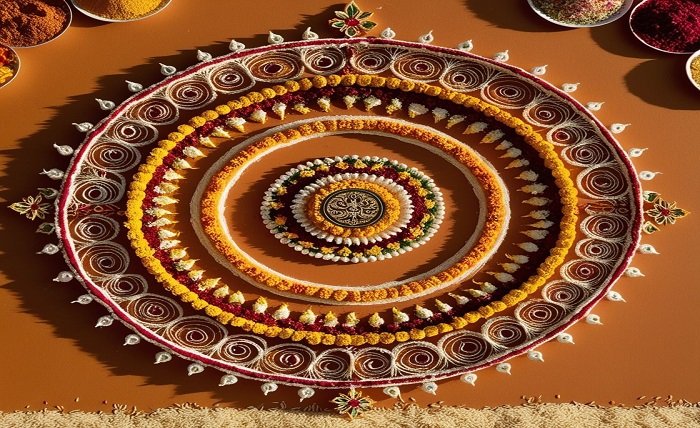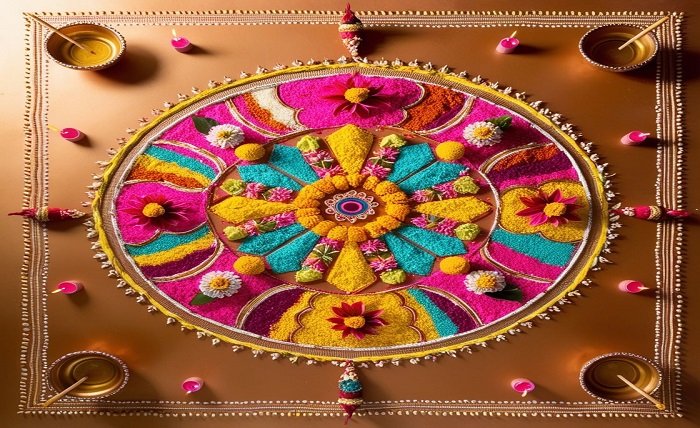Overview
A lively and essential component of Indian culture, rangoli designs stand for happiness, wealth, and hospitality. These elaborate designs are typically formed using rice, flour, flower petals, and bright powders at festivals and other important events. Generation after generation has carried on the tradition of making rangoli, which has changed with contemporary influences while retaining its traditional value. The history of rangoli, different designs, procedures, and how to make beautiful rangoli designs at home will all be covered in this blog post.
The Background of Rangoli
History and Importance
Rangoli is an ancient Indian art form that has been practiced for thousands of years. It is thought to have started in Maharashtra, where it was first known as “Kolam.” Rangoli was traditionally made at home entrances to attract prosperity and fight off evil spirits. Each pattern is distinct and significant since the designs frequently represent local customs, religious beliefs, and seasonal changes.
Cultural Significance
Rangoli has profound cultural importance and is more than just an art form. Making rangoli is seen as a custom that brings blessings and good fortune in many homes. Intricate rangoli designs are created to commemorate holidays like Diwali, Pongal, and Onam also to welcome gods into households. Families frequently join together to make and enjoy the art together, so these colorful patterns also promote a sense of community.
Different Rangoli Design Types
Conventional Designs
Traditional rangoli designs frequently include floral motifs, geometric patterns, and emblems of different gods. Typical components include:
- Geometric Designs: These consist of basic forms like triangles, squares, and circles organized in complex patterns.
- Floral Themes: Symbolizing beauty and the natural world, flowers and leaves are common rangoli motifs.
- Religious Symbols: Numerous rangoli patterns incorporate images of Hindu gods and goddesses, like peacocks and lotus blossoms.
Modern Designs
Rangoli has changed to incorporate modern designs that combine inventive patterns with classic themes as a result of current influences. Several well-liked contemporary styles are:
- Abstract Patterns: These patterns frequently use freeform colors and shapes that encourage individuality and creativity.
- Themed Designs: Modern rangoli might incorporate festival emblems or floral arrangements to represent current events, themes, or trends.
- 3D Rangoli: Artists use various materials to make three-dimensional rangoli, which gives the artwork depth and dimension.
Resources for Rangoli
Conventional Resources
The following materials are used traditionally to make rangoli designs:
- Powders with colors: Typically, natural ingredients like rice flour, turmeric, or flower petals are used to make them. Vibrant designs are possible since they are available in a variety of colors.
- Rice and Flour: To highlight the link to nature, a blend of rice flour or wheat flour is utilized in many areas. This flour can also be consumed by ants or birds.
- Flower Petals: Especially during celebratory events, fresh flowers are frequently utilized to make lovely and fragrant arrangements.
Contemporary Materials
Additional materials are frequently used by contemporary painters, including:
- Sequins and glitter: These components offer glitz and can improve the rangoli designs’ aesthetic appeal.
- Synthetic Colors: Although conventional colors are favored, synthetic colors are also accessible and provide a greater range of creative options.
- Stencils: For individuals who are unfamiliar with rangoli, stencils can make it simple to construct complex designs while maintaining accuracy and consistency.
Methods for Making Rangoli
Fundamental Methods
Depending on the rangoli designs, making might be easy or difficult. Here are some fundamental methods to get you going:
- Drawing by Hand: The most conventional approach uses colored powders to draw designs freehand. Creativity is permitted, but accuracy takes practice.
- Using Stencils: Using stencils can assist novices in producing consistent designs. Fill the stencil with colored powders after placing it on the ground.
- Dot Method: This method entails making a grid of dots and joining them to create complex designs. For people who have trouble with freehand designs, it offers a guide.
Advanced Methods
Take into consideration these sophisticated methods if you want to improve your rangoli designs abilities:
- 3D Rangoli: To produce a three-dimensional impression, add depth by applying layers of color or utilizing various materials.
- Using Natural Dyes: For a more natural coloring method, try using natural dyes derived from flowers and plants.
- Including Lighting: The rangoli’s beauty can be enhanced, particularly during events held at night, by surrounding it with LED lights or diyas (oil lamps).

Celebrations & Events for Rangoli
The holiday of Diwali
The festival of lights, Diwali, is one of the most important times to make rangoli designs. Colorful decorations are used to decorate homes’ doors, signifying the triumph of light over darkness and the coming of prosperity. Intricate patterns, lamps, and images of Lakshmi, the goddess of riches, are frequently included in elaborate designs.
Pongal.
Pongal is celebrated in South India with traditional rice flour rangoli designs creations. In keeping with the festival’s harvest theme, these designs frequently include themes like suns, cows, and pots. In an effort to welcome wealth, families get together to make lovely kolams, which are rangolis.
The Onam
Another event where rangoli is essential is Onam, Kerala’s harvest celebration. These flower arrangements, called Pookalam, are made with vibrant flower petals in a variety of patterns. As the event goes on, Pookalam gets bigger and more intricate, exhibiting ingenuity and camaraderie.
How to Create Your Own Rangoli Design
Detailed Instructions
Making rangoli designs may be enjoyable and fulfilling. Here’s a quick, step-by-step tutorial to get you going:
- Select a Design: Choose a design according to the occasion and your level of expertise. Consult books or the internet for ideas.
- assemble the materials: Gather all required ingredients, such as rice flour, flower petals, or colored powders.
- Get the Surface Ready: The space where the rangoli will be made should be cleaned. The best surface for intricate designs is one that is smooth and level.
- Describe the Design: As a reference, lightly sketch your design on the ground using flour or chalk.
- Fill in the Colors: Start using colored powders to fill in the design. To preserve symmetry, begin in the middle and work your way outward.
- Add Finishing Touches: For a final touch, add other components to your rangoli, such as glitter, diyas, or flower petals.
Success Advice
- Practice Frequently: As with any art form, consistent practice will boost your abilities and self-assurance.
- Be Creative: Don’t be scared to try out different hues and designs. Rangoli is a way for people to express themselves.
- Engage Other People: Ask friends or relatives to help you make rangoli. It may be a cooperative and enjoyable activity.
Final Thoughts
Designs for rangoli are a stunning fusion of creativity, tradition, and culture. They capture the essence of festivals, festivities, and the delight of belonging to a community. Despite its ongoing evolution, this art form is still a treasured custom in Indian homes, bringing luck and prosperity. rangoli designs making is a great method to show your artistic flare and connect with your ancestry, regardless of your level of skills.
Read more about: 99math

